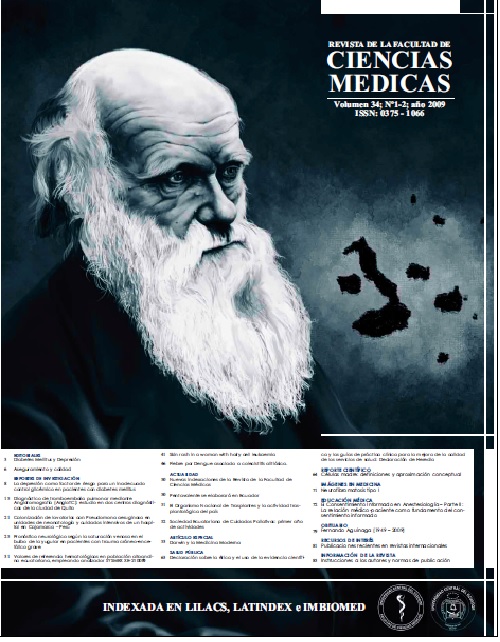Células madre: definiciones y aproximación conceptual.
Abstract
La investigación avanzada en células madre trata sobre como un organismo desarrolla de una simple célula un organismo adulto o como reemplaza las células dañadas. Está es una prometedora área de investigación que permitirá el desarrollo de terapias celulares que son llamadas Medicina Regenerativa o Reparativa. Las stem cells son hoy por hoy la más fascinante área de la biología, que está expandiéndose rápidamente y generando nuevos descubrimientos. En esta revisión tratamos sobre conceptos básicos enfocados en el origen de las células y sus aplicaciones en la medicina.
Downloads
Metrics
References
2. Kochupillai V, Sharma S, Francis S, Mehra NK, Nanu A, Verma IC, et.al. Fetal liver infusion: an adjuvant in the therapy of acute myeloid leukemia (AML). Prog Clin Biol Res 1985; 193: 267-79.
3. Kochupillai V, Sharma S, Francis S, Mehra NK, Nanu A, Kalra V, et.al. Bone marrow reconstitution following human fetal liver infusion (FLI) in sixteen severe aplastic anemia patients. Prog Clin Biol Res 1985; 193: 251-65.
4. Petrenko YA, Jones DR, Petrenko AY. Cryopreservation of human fetal liver hematopoietic stem/progenitor cells using sucrose as an additive to the cryoprotective medium. Cryobiology 2008; 57(3):195-200
5. Hatch M, Ron E, Bouville A, Zablotska L, Howe G. The Chernobyl disaster: cancer following the accident at the Chernobyl nuclear power plant. Epidemiol Rev 2005; 27: 56-66.
6. Kiessling A, Anderson S. Human embryonic stem cells. Sudbury: Jones and Bartlett Publishers; 2003.
7. Orlic D, Kajstura J, Chimenti S, Jakoniuk I, Anderson SM, Li B, et.al. Bone marrow cells regenerate infracted myocardium. Nature 2001; 410: 701 - 5.
8. Leri A, Kajstura J, Anversa P. Identity deception: not a crime for a stem cell. Physiology 2005; 20: 162-168.
9. Pomerantz J, Blau H. Nuclear reprogramming: a key to stem cell function in regenerative medicine. Nat Cell Biol 2004; 6: 810 - 16.
10. . Tosh D, Slack J. How cells change their phenotype. Nat Rev Mol Cell Biol 2002; 3: 187-194.
11. Quinn J, Kunath T, Rossant J. Mouse trophoblast stem cells. Methods Mol Med 2006; 121: 125-48.
12. Anonymous. No consensus in stem cells. Nature 2004; 428: 587.
13. Chien K. Stem cells: lost in translation. Nature 2004; 428: 607- 8.
14. Murry C, Soonpaa M, Reinecke H, Nakajima H, Nakajima HO, Rubart M, et. al. Haematopoietic stem cells do not transdifferentiate into cardiac myocites in myocardial infarcts. Nature 2004; 428: 664 - 8.
15. Theise N, Krause D and Sarkis S. Little evidence for developmental plasticity of adult hematopoietiuc stem cells. Science 2003; 299: 1317.











